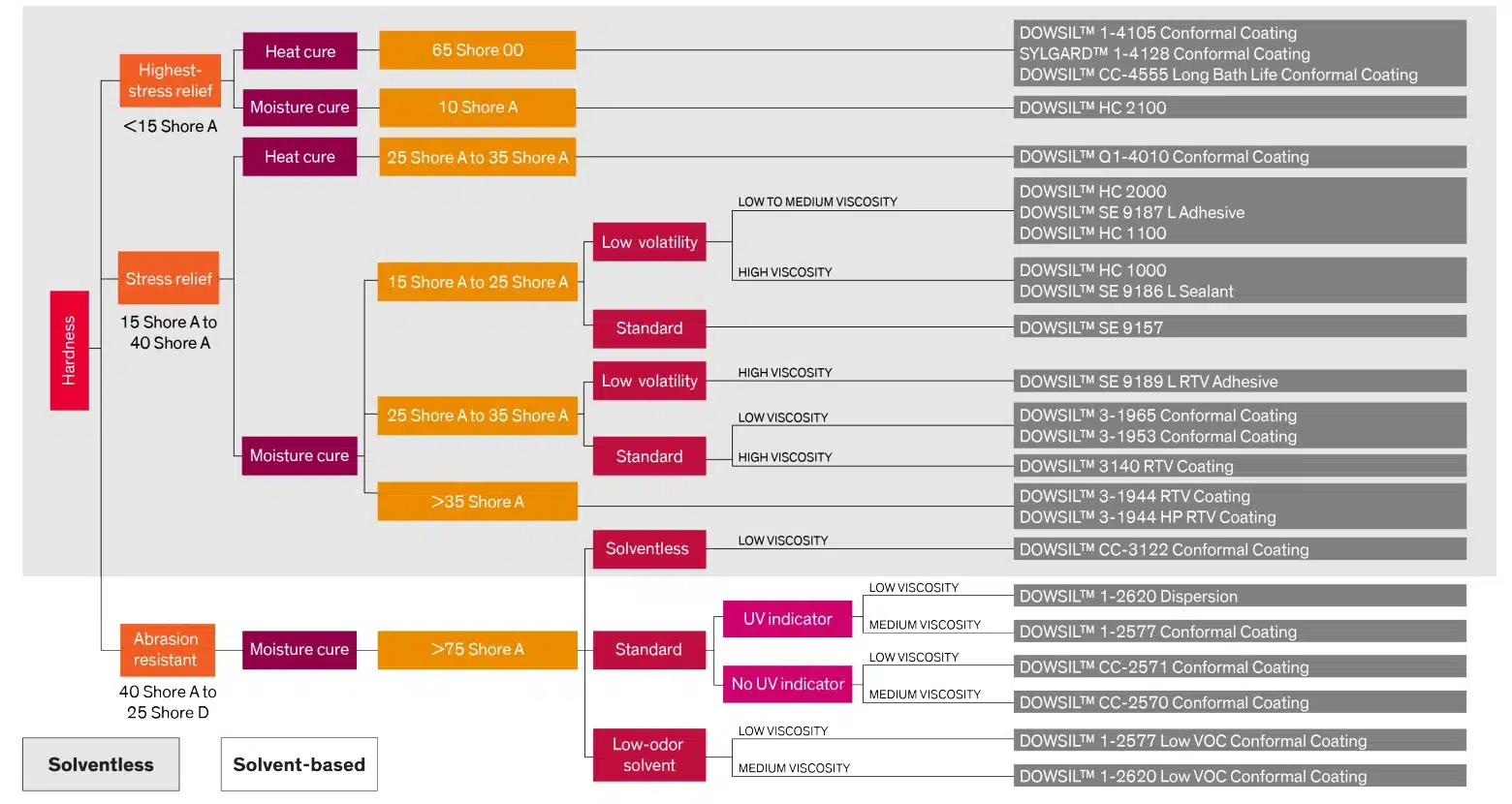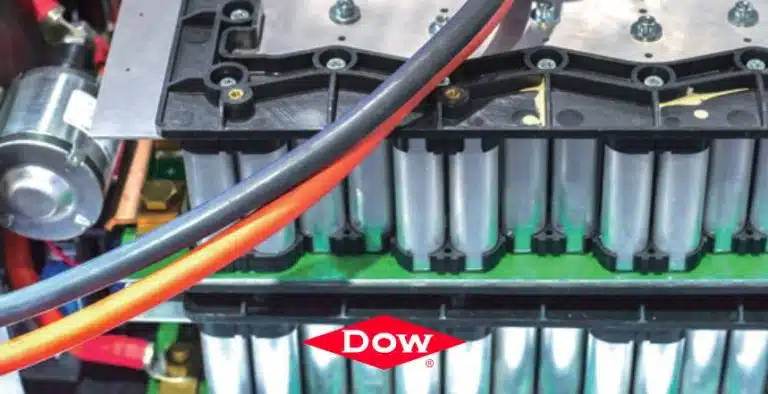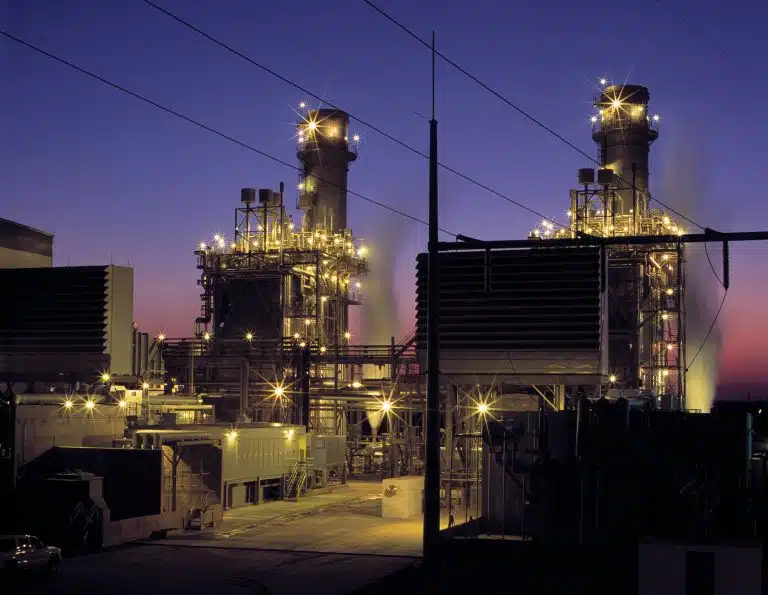Benefits of Silicones from Dow
- Extensive product line
- Proven application performance
- Leading global technical service
- A commitment to quality
- Fully global supply capability
- Continuing innovation
Silicone Adhesives and Sealants
Benefits of DOWSIL™ Silicone Adhesives and Sealants
Wide Temperature Range
- Many products can be used from -65ºC to 232ºC (when fully cured)
Extremely Weather-Resistant
- Virtually unaffected by weather – including rain, sleet, snow, ultraviolet (UV) radiation, ozone and temperature extremes
Good Dielectric Properties
- Good dielectric properties over wide thermal-cycling conditions
Good Bond Strength
- Specially designed to provide good adhesion and bond strength to a variety of surfaces
Low Flammability
- In fire conditions, DOWSIL™ silicone adhesives and sealants are reluctant to burn; in fact, some grades are exceptionally flame-retardant
Good Chemical Stability
- Ideal for use in applications exposed to harsh environments
Environment
- Dow is always striving to improve operations, working largely from the framework of the Responsible Care® Pollution Prevention Code
![]()
Application Example: Stovetop Sealing
Application Needs
- Sealing frame to kitchen counter
- Sealing/bonding glass (adhesive seal)
Material Requirements
- Heat resistance
- Hot water resistance
- Good adhesion
- Good tooling
Potential Product Solutions
- Adhesive seal: DOWSIL™ 732 Multi-Purpose Sealant
- DOWSIL™ EA-2626 Adhesive
- SILASTIC™ Q3-3636 Adhesive
- DOWSIL™ Q3-1566 Heat Resistant Adhesive/Sealant
- Silicone Foams
Target Customers
- Ceramic hob manufacturers

Application Example: Supermarket Display
Application Needs
- Gap filling/bonding
Material Requirements
- Good adhesion to various metals, plastics and glass
- Water resistance
- Flexible bond at low temperatures
Potential Product Solutions
- DOWSIL™ 732 Multi-Purpose Sealant
- DOWSIL™ 737 Neutral Cure Sealant
- DOWSIL™ 7091 Adhesive Sealant
- DOWSIL™ AS 7096N Sealant
- DOWSIL™ HM-2600 Silicone Assembly Sealant
Target Customers
- Industrial freezer display case manufacturers

Application Example: Commercial Kitchen Equipment
Application Needs
- Adhesive seal
- Gap filling/bonding
Material Requirements
- Good adhesion to various metals, plastics and glass
- Heat resistance
- Fluid resistance (hot water, detergent)
Potential Product Solutions
- DOWSIL™ 732 Multi-Purpose Sealant
- DOWSIL™ 736 Heat Resistant Sealant
- DOWSIL™ 733 Glass & Metal Sealant
- DOWSIL™ Q3-1566 Heat Resistant Adhesive/Sealant
- DOWSIL™ 7091 Adhesive Sealant
Target Customers
- Kitchen equipment manufacturers

Application Example: Oven Door, Microwave Door
Application Needs
- Bonding outer window to frame
- Bonding inner window to frame
Material Requirements
- Heat resistance (up to 250°C)
- Good adhesion to glass
• Good adhesion to painted metal
Potential Product Solutions
• DOWSIL™ 3-6096 Adhesive
• DOWSIL™ Q3-3526 Sealant
• DOWSIL™ 736 Heat Resistant Sealant
• DOWSIL™ 732 Multi-Purpose Sealant
• DOWSIL™ EA-2626 Adhesive
• SILASTIC™ Q3-3636 Adhesive

Application Example: Refrigerator
Application Needs
• Seam sealant for plastic/plastic or plastic/metal
• Bonding silicone rubber gasket to cover
Material Requirements
• Good adhesion to plastic and metal
• Good adhesion to silicone rubber
• Good adhesion/flexible bond at low temperatures
Potential Product Solutions
• DOWSIL™ 732 Multi-Purpose Sealant
• DOWSIL™ 737 Neutral Cure Sealant
• DOWSIL™ 748 Non-Corrosive Sealant
• DOWSIL™ 750 Plastic Surface Adhesive/Sealant
• DOWSIL™ 7091 Adhesive Sealant
• DOWSIL™ AS 7096N Sealant
Target Customers
• Refrigerator manufacturers

Application Example: Washing Machine Cover
Application Needs
• Sealing and bonding
• Enhanced productivity
Material Requirements
• Good adhesion, developed quickly
• High green strength
• Clarity
Potential Product Solutions
• DOWSIL™ HM-2500 Assembly Sealant
• DOWSIL™ HM-2600 Silicone Assembly Sealant
• DOWSIL™ 7091 Adhesive Sealant
• DOWSIL™ EA-2626 Adhesive
Target Customers
• White-good manufacturers

Silicone Hot-Melt Adhesives
Benefits of DOWSIL™ Silicone Hot-Melt Adhesives
- True family with members
- Multipurpose with FDA & NSF
- High-temperature stability
- Flowable, self-leveling behavior
- Durable adhesion to most substrates without primer
- Enable productivity with fast green strength
- Can ship parts quickly
- Clear
Typical Properties of Silicone Hot-Melt Adhesives

These values are not intended for use in preparing specifications.
1 – 180º peel from various substrates based on ASTM C794: 21-day cure + 7-day H2O immersion.
2 – Shear Adhesion Failure Temperature based on ASTM 4498 but with a 0.10-in bondline.
3 – Industrial, Appliance and Maintenance.
4 – PCB and Systems Assembly.
Silicone Conformal Coatings
Overview: Conformal Coatings
Description and Use
- Thin protective films/breathing membranes that filter water vapor and solid debris
- Provide environmental and mechanical protection of circuitry and components
- Used in thicknesses of 25 to 200 μm
Key Benefits of DOWSIL™ Conformal Coatings
- Improve reliability in humid environments
- Protect PCBs and other system components against environmental particles, moisture and contaminants, preventing short circuits and corrosion of conductors and solder joints
- Protect circuits and components from abrasion and solvents
- Stress-relieving
- Protect insulation resistance
- Reduce conductor spacing on PCBs
- Offer good dielectric properties (insulation, moisture resistance, breakdown voltage)
Industry Trends for Conformal Coatings

Why Use Silicones?
![]()
Cure Profile Options for Conformal Coatings
Fast moisture-cure
- Quick room-temperature cure
- A “dispense-and-forget” solution; tack-free and ready for production in <10 minutes
- Ideal option for high-volume assembly operations
Extended-working-time moisture-cure
- Extended room-temperature cure to allow the material to flow farther over large or complex boards
- Preferred solution for applications that require a thicker coating
Heat cure
- “Command cure” materials provide control of cure rate
- Material of choice when processing operations demand full cure in <5 minutes
- May impose lower stress on board components during thermal cycling
Conformal Coatings Product Selection Tree

Silicone Thermally Conductive Materials
Industry Trends for Thermally Conductive Materials
Improved thermal management is increasingly critical
to maintaining long-term performance and reliability
of PCB module assembly in virtually every industry.
General Trends
- High-functionality/high-performance appliances require higher power density, leading to increasing temperatures
- Improved thermal management is required to dissipate heat in these devices for improved performance, reliability and lifetime
- Improved thermal management also improves design flexibility
- Form factor optimization is a key challenge – “thin is in”
- Increasing demand for higher performance and more cost-effective thermal management solutions
Overview: Thermally Conductive Adhesives
Description
- High-performance materials range from low-viscosity liquids to nonslump formulations
- No significant by-products during processing, allowing use as structural adhesives without mechanical fasteners, even in complete confinement
Product Types
- One-part moisture-cure grades offer simple room-temperature processing to minimize costs
- One- or two-part heat-cure solutions help accelerate processing to speed time to market
Benefits
- Strong bonds that dissipate heat
- Expanded design and process flexibility
- Enhanced design flexibility by filling oddly-shaped gaps and generating large contact areas to maximize heat transfer
- Ease manufacturing challenges when part planarity and fit tolerances cannot be tightly controlled
- Surface contact helps reduce interfacial resistance
- After cure: Adhesive becomes a strong yet flexible elastomer; delivers good unprimed adhesion to a variety of common substrates, including metals, ceramics and filled plastics
Applications: Thermally Conductive Adhesives
Typical Applications
Bonding and sealing of hybrid circuit substrates, semiconductor components, heat spreaders and other applications that demand broad design, flexible processing options and excellent thermal management.

Overview: Thermally Conductive Compounds
Description
- Serve as thermal bridges that draw heat away from a device’s sensitive PCB module components and dissipate it into the ambient environment
- No-cure materials
Benefits
- Low thermal resistance
- High thermal conductivity
- Ability to achieve very thin bond line thickness
- Relatively low cost
- Easy application onto heat sinks via screen printing; ease of rework
- Maintain consistency at high temperatures to form positive seals with heat sinks, ensuring reliable device performance
- Particularly suitable for applications in which heat sinks are removed and reattached later, or where the PCB module assembly favors no-cure processes
Applications: Thermally Conductive Compounds
Typical Applications
Sensitive PCB module components, LED lighting application, Power application such as IGBT module, telecom equipment, consumer electronics, power supplies and power components for transportation, etc.

Overview: Thermally Conductive Elastomers & Gels
Description
• Adaptable products for encapsulation and potting applications
• Broad family of material technologies offers versatile thermal management solutions
• Available in a range of hardness and stress relief levels
Benefits
• Low viscosity before cure of these products enables easy processing; fully embed tall components, delicate wires and solder joints
• Particularly suitable for managing high heat in complicated PCB architectures
• Extremely low modulus after cure; provides superb stress-relief
Applications: Thermally Conductive Elastomers & Gels
Typical Applications
PCB system architectures, Potting of high-voltage transformers and sensors; assembly of substrates to heat sinks; gap fill material between heat sources and heat sinks Potting for: On-board charger, Inverter, Converter, Transformer, etc.

Thermally Conductive Materials Product Summary



Silicone Foams (FIPFG)
Uses of Silicone Foams (FIPFG)
Ideal for use when:
- A compression gasket is required
- An “environmental seal” is required (sealing against ambient air, splashed water, dust, moisture)
- A cost-effective sealing solution is required (compared to preformed gaskets/foam tapes)
- High-tolerance gaps exist
- Low sealing force/low modulus is required
- Component sound and vibration require damping
- Gasket installation demands automation (robotic dispensing)
- Serviceability is an issue
- Installation at tier supplier is preferred
- Fast cure (room temperature/low heat) is demanded
Typical Applications of Silicone Foams
- Back caps for headlamps/taillights
- Headlamps/taillights/brake lights
- Housings for PCB system assemblies
- Timing belt covers
- Plastic covers under the hood (“beauty covers”)
- Door modules
- Almost anywhere foam tape is used
- Ceramic hobs and supporting metal frames
- Dishwasher detergent dispenser units
- Outdoor lighting
- Gas boilers
![]()
Processing of Silicone Foams
- A two-part silicone RTV foam is directly dispensed onto the part surface to be sealed
- Once the components are mixed, a foaming agent (H2) is formed
- The dispensed foam gasket expands in its liquid stage and cures to a foamed solid (elastomer) within 10 minutes at room temperature
- Provides a low-modulus integrated compression seal with fine cell-structure
![]()
Flowability of Silicone Foams
Difference between flowable and reduced-flow foams:
![]()
Typical Properties of Silicone Foams
![]()
Source: Dow Technical Library






